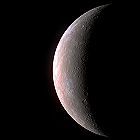 For the first time in over 30 years, a spacecraft from Earth flies past the innermost planet, Mercury. The Messenger space probe, launched in 2004, is due to take up an orbit around Mercury in 2011, but this first close pass – just over 120 miles above Mercury’s surface – is designed to alter its trajectory. Messenger carries little fuel, and has swooped past Earth three times and twice past Venus to use both planets’ gravity to change its heading. Two more close passes of Mercury will be needed before it finally becomes caught in the tiny planet’s orbit, where it will spend roughly a year mapping the planet’s surface and taking dozens of other measurements. The last space probe from Earth to visit Mercury was Mariner 10, which made three close passes in 1974/75. Despite the brief gravity-assist visit, Messenger captures its first 1,200 images of Mercury, including a side of the planet never before seen from Earth.
For the first time in over 30 years, a spacecraft from Earth flies past the innermost planet, Mercury. The Messenger space probe, launched in 2004, is due to take up an orbit around Mercury in 2011, but this first close pass – just over 120 miles above Mercury’s surface – is designed to alter its trajectory. Messenger carries little fuel, and has swooped past Earth three times and twice past Venus to use both planets’ gravity to change its heading. Two more close passes of Mercury will be needed before it finally becomes caught in the tiny planet’s orbit, where it will spend roughly a year mapping the planet’s surface and taking dozens of other measurements. The last space probe from Earth to visit Mercury was Mariner 10, which made three close passes in 1974/75. Despite the brief gravity-assist visit, Messenger captures its first 1,200 images of Mercury, including a side of the planet never before seen from Earth.
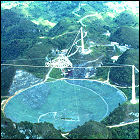 Using the Arecibo Radio Telescope in Puerto Rico, a team of radio astronomers led by Gordon Pettengill makes the determination that Mercury rotates on its axis once every 59 Earth days, a much shorter “day” for Mercury than the previously estimated 88 Earth day rotation. Pettengill is a pioneer of radio and radar astronomy, and will go on to use both methods to study asteroids, Venus, and Earth’s moon.
Using the Arecibo Radio Telescope in Puerto Rico, a team of radio astronomers led by Gordon Pettengill makes the determination that Mercury rotates on its axis once every 59 Earth days, a much shorter “day” for Mercury than the previously estimated 88 Earth day rotation. Pettengill is a pioneer of radio and radar astronomy, and will go on to use both methods to study asteroids, Venus, and Earth’s moon.
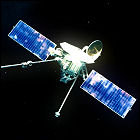 The first unmanned space probe to use a gravity assist maneuver to get from one planet to another in a reduced amount of time, Mariner 10 is lauched on a course for the planet Venus, where a carefully planned trajectory allows it to take pictures and measurements at that planet before using Venus’ gravity to fling Mariner 10 inward toward Mercury, allowing it to reach two planets in under two months. It will be the first space probe to visit Mercury.
The first unmanned space probe to use a gravity assist maneuver to get from one planet to another in a reduced amount of time, Mariner 10 is lauched on a course for the planet Venus, where a carefully planned trajectory allows it to take pictures and measurements at that planet before using Venus’ gravity to fling Mariner 10 inward toward Mercury, allowing it to reach two planets in under two months. It will be the first space probe to visit Mercury.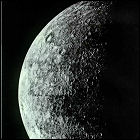 After using the gravity of the larger planet Venus to fling it further toward the sun, NASA’s unmanned space probe Mariner 10 zips by the innermost planet, Mercury, less than 500 miles away from its cratered surface. Its cameras capture the first-ever views of the barren planet, whose surface temperatures vary between frigid on the night side and oven-baked on the hemisphere facing the sun. Mariner 10 passes behind the sun, catching up with Mercury again half a year later.
After using the gravity of the larger planet Venus to fling it further toward the sun, NASA’s unmanned space probe Mariner 10 zips by the innermost planet, Mercury, less than 500 miles away from its cratered surface. Its cameras capture the first-ever views of the barren planet, whose surface temperatures vary between frigid on the night side and oven-baked on the hemisphere facing the sun. Mariner 10 passes behind the sun, catching up with Mercury again half a year later.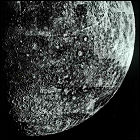 NASA’s unmanned space probe Mariner 10 makes its second pass of the planet Mercury, six months after its first flyby. This time Mariner passes under the planet’s south pole, getting the first views of that part of Mercury, but barely flying within 30,000 miles of the surface. Once again, following its encounter with Mercury, Mariner 10 slipped into a solar orbit that would bring it back to Mercury several months later.
NASA’s unmanned space probe Mariner 10 makes its second pass of the planet Mercury, six months after its first flyby. This time Mariner passes under the planet’s south pole, getting the first views of that part of Mercury, but barely flying within 30,000 miles of the surface. Once again, following its encounter with Mercury, Mariner 10 slipped into a solar orbit that would bring it back to Mercury several months later. For the first time in over 30 years, a spacecraft from Earth flies past the innermost planet, Mercury. The Messenger space probe, launched in 2004, is due to take up an orbit around Mercury in 2011, but this first close pass – just over 120 miles above Mercury’s surface – is designed to alter its trajectory. Messenger carries little fuel, and has swooped past Earth three times and twice past Venus to use both planets’ gravity to change its heading. Two more close passes of Mercury will be needed before it finally becomes caught in the tiny planet’s orbit, where it will spend roughly a year mapping the planet’s surface and taking dozens of other measurements. The last space probe from Earth to visit Mercury was Mariner 10, which made three close passes in 1974/75. Despite the brief gravity-assist visit, Messenger captures its first 1,200 images of Mercury, including a side of the planet never before seen from Earth.
For the first time in over 30 years, a spacecraft from Earth flies past the innermost planet, Mercury. The Messenger space probe, launched in 2004, is due to take up an orbit around Mercury in 2011, but this first close pass – just over 120 miles above Mercury’s surface – is designed to alter its trajectory. Messenger carries little fuel, and has swooped past Earth three times and twice past Venus to use both planets’ gravity to change its heading. Two more close passes of Mercury will be needed before it finally becomes caught in the tiny planet’s orbit, where it will spend roughly a year mapping the planet’s surface and taking dozens of other measurements. The last space probe from Earth to visit Mercury was Mariner 10, which made three close passes in 1974/75. Despite the brief gravity-assist visit, Messenger captures its first 1,200 images of Mercury, including a side of the planet never before seen from Earth.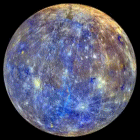 The unmanned Messenger space probe, the first spacecraft ever to orbit Mercury, completes the mapping of the tiny planet with its MDIS (Messenger Dual Imaging System), having completed full coverage of the entire planet from pole to pole in both visible and infrared light, allowing a much more accurate topographical map to be created. This represents the most complete set of mapping data available on Mercury. Messenger’s mission is slated to end in March unless it is extended a second time.
The unmanned Messenger space probe, the first spacecraft ever to orbit Mercury, completes the mapping of the tiny planet with its MDIS (Messenger Dual Imaging System), having completed full coverage of the entire planet from pole to pole in both visible and infrared light, allowing a much more accurate topographical map to be created. This represents the most complete set of mapping data available on Mercury. Messenger’s mission is slated to end in March unless it is extended a second time.